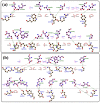The Expansion of the Spectrum in Stuttering Disorders to a Novel ARMC Gene Family (ARMC3)
- PMID: 36553564
- PMCID: PMC9778410
- DOI: 10.3390/genes13122299
The Expansion of the Spectrum in Stuttering Disorders to a Novel ARMC Gene Family (ARMC3)
Abstract
Stuttering is a common neurodevelopment speech disorder that negatively affects the socio-psychological dimensions of people with disability. It displays many attributes of a complex genetic trait, and a few genetic loci have been identified through linkage studies. Stuttering is highly variable regarding its phenotypes and molecular etiology. However, all stutters have some common features, including blocks in speech, prolongation, and repetition of sounds, syllables, and words. The involuntary actions associated with stuttering often involve increased eye blinking, tremors of the lips or jaws, head jerks, clenched fists, perspiration, and cardiovascular changes. In the present study, we recruited a consanguineous Pakistani family showing an autosomal recessive mode of inheritance. The exome sequencing identified a homozygous splice site variant in ARMC3 (Armadillo Repeat Containing 3) in a consanguineous Pashtun family of Pakistani origin as the underlying genetic cause of non-syndromic stuttering. The homozygous splice site variant (NM_173081.5:c.916 + 1G > A) segregated with the stuttering phenotype in this family. The splice change leading to the skipping of exon-8 is a loss of function (LoF) variant, which is predicted to undergo NMD (Nonsense mediated decay). Here, we report ARMC3 as a novel candidate gene causing the stuttering phenotype. ARMC3 may lead to neurodevelopmental disorders, including stuttering in humans.
Keywords: ARMC3; autosomal recessive; exome sequencing; splice site variant; stuttering.
Conflict of interest statement
The authors declare no conflict of interests.
Figures




References
-
- Martin R.R., Haroldson S.K. Stuttering identification: Standard definition and moment of stuttering. J. Speech. Hear. Res. 1981;24:59–63. - PubMed
-
- Månsson H. Childhood stuttering: Incidence and development. J. Fluen. Disord. 2000;25:47–57.
Publication types
MeSH terms
Substances
LinkOut - more resources
Full Text Sources
Medical
Molecular Biology Databases

